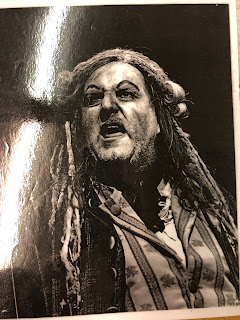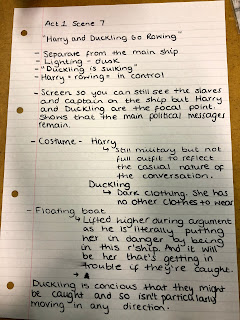The director of a performance is one of the most important people in the whole process of creating a performance and it is essentially their interpretation of the practitioner and so they are involved with everyone so that they can achieve the best display of acting and hard work. They can be a permanent member of a set theatre or they can be hired for a particular show. They develop and implement their artistic vision for the piece with the possible help from an Assistant director and a choreographer, who would oversee both dance sections, if needed, and/or staged fight scenes to ensure that they are safe, rehearsed and managed. Although unless the director is very experienced and successful being a director can be unpredictable in terms of employment as a theatre may not employ them if they haven't got any past work to account for and to show the influence that you have had in past productions. The responsibility that is placed upon a director is greater than any other as they are generally responsible for everything and everyone included under that bracket which means that many questions are going to be directed towards them as so they need to be able to work quickly yet efficiently in order to get the play to a performance ready whilst having their artistic vision to be correct and presentable.
One of the roles that are included in a theatre are the Ushers who's job it is to guide people there seats and make sure that everyone is sat in their designated seats smoothly. They are the public face of the theatre and normally work throughout the performance and act as a base for the audience to ask questions about both the theatre and the performance. They also sell programmes, merchandise and refreshments during the interval which means that they overlook the sources of income in the theatre during the performance. They are also responsible for the health and safety of the audience and the safe evacuation from the theatre. Representing the theatre means that they need to be portraying the theatre in a positive light at all times and making sure that the audience feel comfortable both while watching the performance and going in and out of the theatre.
Theatre designers such as the set designer, costume designer, and the lighting designer are the key to the Director's artistic vision coming to life on stage and in terms of the set designer they are responsible for transporting the audience into another place or time and making it believable. The positions can be combined if the production is of a smaller budget and proportion. Set designers need to be able to take the ideas of those around them and put them into 3D objects on the stage. They could need to work with other roles such as the production manager, stage managers and the lighting crew in order to build the set according to plans that they have been given and so they need to be able to listen to everyone and then combine those wants into the set. They may need to do their own construction as well as making drawings of the possible set for the director to review, if the theatre does not have it's own construction crew. As a set designer they may need fine art training before hand in order to accentuate their aesthetic sense for design and construction. They need to be patience with demands of the director and need to be open for change in case the design is not what the director wanted it to look like. A set designer may need to work under time restrictions and budgets which means that they need to be able to work with other people in a short space of time and if the production is on a larger scale this could become particularly stressful. The director may want to change an aspect of the set in a time that is close to the performance and this may lead to possible long hours or a hectic schedule before the production opens. They would need to thrive under this pressure and work as hard as possible in order for the set to meet the design brief.
In terms of costume designers they may also work with the set designer to make sure that they both reflect the time period in which the play is set. They are focused around dressing the actors on stage in a particular way that reflects the time in which the play is set and making it realistic. To become a Costume director the academic needs are less than that of a director and so you could enter this line of work with just a diploma in any type of art or specifically fashion. A costume designer needs to be passionate about their work and be able, like a set designer, to put the design brief onstage and to fill the expectations of the director. Like a set designer they will have to work with deadline and possibly under pressure which means that they need to be time-aware and be able to use their time wisely. Costume designers need to be able to react to criticism of their work in an orderly manner that reflects not only themselves but the theatre they are working for as well. The costume industry is very competitive which means that in order for you to get the job you need to be able to distance yourself from other competitors and make your designs stand out.
Another designer that is included in the theatre is the lighting designers who are responsible for lighting the stage in relation to the setting and the time of each scene. This means that they can be controlling up to 50 lights at a time and they will most likely be changing from scene to scene and so they will need to keep a level head throughout in order for the lighting changes to run smoothly. They are contributing to the overall atmosphere of the productions and help set the scene for the audience. They too, follow the directions that they are given yet they do get their opinions heard more than others as they need to be educated in how to use a lighting desk and, depending on experience, may know the best ways to achieve the directors design brief. They will also have to deal with last minute changes by the director and have to work long hours in order to set the lights to what they need to be and be able to use them in a performance easily.
A stage manager is a role which entails overlooking all of the backstage jobs including all designers and they are responsible for the organisation of backstage crews and the cast during performance as well as during the rehearsal process. There can often be more than one manager and so they need to be able to work as a team in order to run a performance as smoothly as possible although in smaller productions there are normally just one stage manager. They are normally associated with a company as a freelancer or can be part of the permanent stage crew at certain theatres. Stage managers need to be have a wide range of knowledge about the theatre itself and methods that can be used in order to make a performance run smoothly. They are responsible for the health and safety of both the performers and the stage crew for every performance as well as ensuring that all departments have reached the goals that were set for them at the start of the rehearsal process for the production to be performed to its greatest potential during rehearsals as well. Their jobs may include pre-show prop checks, safety checks and movement rehearsal. They co-ordinate the show and so need to be able to control a large amount of people and be work-driven so that everything is completed in the time frame given. They may even have to organise props and assist with set and costume changes during the performances to make sure that the performance can carry on without disruption.
Another key position in a theatrical performance is the actor onstage. They are constantly being watched throughout the rehearsal process and in the performance as they are the focal people who are telling the story of their characters. They need to be dedicated to their jobs as securing a job can be very hard and so they need to be resilient as they may face a lot of rejection and they need to be able to come back from that and pursue on-wards to other auditions. They need to put an immense amount of time and effort into the portrayal of their characters in order to make it realistic for the audience. An actor needs to be to take criticism and direction in order for the character to be played in a certain way that fits the directors interpretation and so they need to be open to suggestions about their work and be able to change anything, whether that be their tone of voice or body language, without interference.
For the past two years, I have been taking BTEC performing arts at A level and previously before that 2 years of GCSE drama which are two of the steps that could be needed to gain the job of an actor. After A levels, there are an array of different university degrees that I could take in order to reach the goal of an actor from Actor training to Musical theatre to performing arts and these are offered at many universities around the UK. Whilst in university, there are many audition opportunities including the National Youth Theatre which is based around 19-25 year olds and they give courses in acting and backstage opportunities. The more audition opportunities that I take, the more experience that I would have with auditioning and the more confidence I would gain. Also the more auditions I attend the more my name would become recognisable and therefore I would become more known for my acting skills. These steps would hopefully give me the opportunities to become an actor in the future.
For the past two years, I have been taking BTEC performing arts at A level and previously before that 2 years of GCSE drama which are two of the steps that could be needed to gain the job of an actor. After A levels, there are an array of different university degrees that I could take in order to reach the goal of an actor from Actor training to Musical theatre to performing arts and these are offered at many universities around the UK. Whilst in university, there are many audition opportunities including the National Youth Theatre which is based around 19-25 year olds and they give courses in acting and backstage opportunities. The more audition opportunities that I take, the more experience that I would have with auditioning and the more confidence I would gain. Also the more auditions I attend the more my name would become recognisable and therefore I would become more known for my acting skills. These steps would hopefully give me the opportunities to become an actor in the future.



















